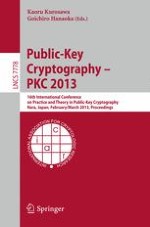2013 | Buch
Public-Key Cryptography – PKC 2013
16th International Conference on Practice and Theory in Public-Key Cryptography, Nara, Japan, February 26 – March 1, 2013. Proceedings
herausgegeben von: Kaoru Kurosawa, Goichiro Hanaoka
Verlag: Springer Berlin Heidelberg
Buchreihe : Lecture Notes in Computer Science
